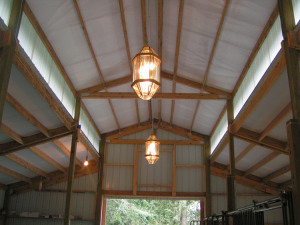For decades, the least expensive solution to bringing natural light into post frame buildings has been what is known as “eave lights”.
 Eave lights are typically short portions of translucent material installed usually in the upper portion of one or both eave sidewalls.
Eave lights are typically short portions of translucent material installed usually in the upper portion of one or both eave sidewalls.
Back in “the day”, opaque fiberglass (actually fiberglass reinforced plastic or FRP) was the eave light material of choice. The FRP panels were manufactured with roughly the same rib configuration as the wall steel.
A downside of fiberglass panels is they have a very low tolerance for the sun’s UV rays. Due to this, they degrade rather quickly, turning yellow and becoming brittle. This causes them to crack and break. They also become easy prey for youthful vandals who tend to be attracted to them as targets for rocks and other throw projectiles. The gradual fade to yellow is both aesthetically unpleasing and it causes a reduction in the amount of light transmission.
When I was first in the pole building industry, the standard installation procedure was to order the wall steel panels shorter than normal by 18 inches, then place 24 inch long fiberglass panels above them, overlapping the steel below by six inches. While cheap and easy, there were downsides to this installation other than just the inherent issues of FRP.
The six inch overlap, while creating a weather seal, allowed the underlying steel to be seen through the light panel. The manufacturing processes of eave light panels and steel siding are quite different. Light panels are extruded which tends to create more rounded profiles than the roll formed steel panels. The two materials also thermally expand and contract at differing rates. The end resultant being an overlap which never seems to lay smoothly.
In the mid-1980’s a better alternative to FRP panels was developed – polycarbonate. With trademark names such as Lexan and Sunsky, polycarbonates are very durable and have high impact resistance (in the case of SunSky up to 20 times more). Virtually unbreakable, polycarbonate eave light panels have better light transmission characteristics than many types of glass.
In the case of SunSky polycarbonate panels, they are self-extinguishing in the event of fire, will not yellow, retain optical clarity far better than any other glazing material, are hail and wind resistant, afford 100% UV protection and are UL 580 Class 90 recognized.
Installation techniques have also improved from the old fashioned overlap method. Now standard 36 inch length panels are used, and a Z style steel trim is placed at the top of the steel wall panels. This flashing extends up behind the eave light panels, and slightly down the face of the steel sheets. It affords a weather tight seal, and eliminates the poor overlapping issues which were caused by differences in manufacturing process and expansion/contraction.
Polycarbonate panels can also be affordably installed across the triangles of the trusses at the ends of buildings; however keep in mind, the roof truss webbing will be noticeable through the panels.







I am curious about heat. While letting natural light into the barn is fantastic, and it looks nice as well. My question is regarding the insulation of the lights. Would more heat enter the barn than without the lights? An example would be a barn in sitting directly in the sun in South Florida where the sun blasts year round. The heat is something all Floridians want to block as much as possible in our barns. Are there different light panels that have a higher r-value or maybe even sun reflection qualities?
Jenny ~ In all probability, the eave light panels are probably not going to transfer heat much differently than the steel siding will. Your best bet for reduction of heat gain would be to use at least double pane windows for letting natural light in and then place reflective insulation under the steel siding.